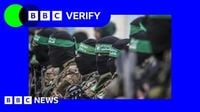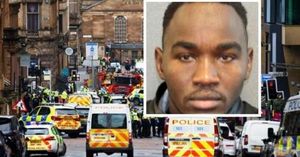On Sunday, September 21, 2025, Gaza City witnessed a chilling spectacle: three Palestinian men, accused of collaborating with Israel, were executed in broad daylight by masked Hamas gunmen. The scene, which unfolded on a street outside Shifa hospital, was captured in graphic footage that quickly spread across social media and news outlets, shaking a region already battered by war and deepening divisions.
According to BBC Verify, the location of these executions was verified as being outside Shifa hospital, now a focal point of Israel’s ongoing ground offensive in Gaza City. The video, initially posted on a Hamas-affiliated Telegram group, shows at least five armed and masked men overseeing three blindfolded prisoners. As a fourth man reads out the death sentence in Arabic, a crowd gathers, some chanting “Allahu Akbar!”—a phrase meaning “God is most great”—in what sounds like encouragement for the brutal act. The condemned, kneeling and helpless, are shot several times in the head and upper body. Hamas gunmen then placed handwritten notes on their bodies, warning, “Your betrayal will not pass without punishment. A harsh punishment awaits.”
Hamas’s ministry of the interior described the executed men as a “group of outlaws” who had collaborated with the Jewish state. The death sentence, the gunman declared, was “pursuant to the content of Palestinian revolutionary law and based on the Palestinian revolutionary court,” for those who “betrayed the homeland, betrayed their people and betrayed their cause, and put [themselves] hand-in-hand with the occupation in order to kill their own people,” as translated and reported by The Committee for Accuracy in Middle East Reporting and Analysis for The Telegraph.
But Hamas was not alone in this grim affair. Israeli newspaper Israel Hayom reported that Islamic Jihad and the Mujahideen Brigades—both formally designated as terrorist organizations by the United States—also took part in the executions. A Palestinian security official from the Hamas-run Gaza government told Reuters that the killings were conducted by the “Joint Operations Room of the Palestinian resistance,” a rare public admission of such a coordinated act.
One of the executed men, Yasser Abu Shabab, was singled out as a “major collaborator.” Abu Shabab, a prominent figurehead of a clan reportedly armed by Israel, has operated in Rafah—an area under Israeli military control. His clan has presented itself as an opposition force to Hamas, further complicating Gaza’s fractured internal landscape. In July, Israeli Prime Minister Benjamin Netanyahu confirmed that Israel was arming clans in Gaza “opposed to Hamas.” However, Abu Shabab himself publicly denied that Israel had supplied his group with weapons, stating online that he “categorically rejects” the claim.
The emergence of armed clans is not an isolated phenomenon. In July 2025, a senior officer in Hamas’s security forces admitted to the BBC that the group had lost much of its grip over the Gaza Strip, with these clans filling the power vacuum. Reuters further reported that Abu Shabab’s armed group was actively recruiting on social media, and that other groups opposed to Hamas had surfaced in northern Gaza and near Khan Younis in the south. Residents and sources close to Hamas confirmed the rise of these factions, signaling a growing challenge to Hamas’s authority amid the chaos of war.
The executions came less than a day after Canada, the UK, and Australia made the controversial move of formally recognizing Palestine as a UN member state, drawing sharp objections from both the US and Israel. While the timing may be coincidental, the symbolism was hard to miss, as Gaza’s internal strife played out against a backdrop of shifting international allegiances and the enduring Israeli-Palestinian conflict.
This was not the first time Hamas has meted out such public punishments. In May 2025, according to multiple outlets including QudsN and Israel Hayom, Hamas executed six Palestinians accused of looting humanitarian aid and shot another 13 in the legs. During the ongoing war, the group has repeatedly announced public punishments for crimes ranging from looting to collaboration with Israel—acts it claims are necessary to maintain order and discipline in a territory under siege.
Yet, these actions have drawn widespread condemnation. The offensive on Gaza City—home to about one million people, where famine was confirmed as recently as August 2025—has been described as “cataclysmic” by a spokeswoman for the UN’s humanitarian office. She reported a constant stream of Palestinians fleeing south, though hundreds of thousands remain trapped amid the violence and deprivation. The Israeli military, meanwhile, continues its campaign in Gaza City, claiming to have “dismantled military infrastructure used by Hamas” and killed a Hamas cell that had attacked Israeli soldiers, wounding an officer. The stated objectives remain the freeing of hostages still held by Hamas and the defeat of what Israel describes as the group’s “main stronghold,” estimated at up to 3,000 fighters.
The roots of the current conflict trace back to October 7, 2023, when a Hamas-led assault on southern Israel left about 1,200 people dead and 251 taken hostage. Since then, according to Gaza’s Hamas-run health ministry, at least 65,344 people have been killed in Israeli attacks on the territory. The sheer scale of loss, coupled with the collapse of civil order and emergence of new armed factions, has left Gaza in a state of profound crisis.
For many observers, the public executions are a stark reminder of the desperation and brutality that can flourish in a lawless environment. While Hamas and its allies justify such acts as necessary measures against traitors and criminals, human rights advocates and international organizations decry them as extrajudicial killings that further erode the rule of law and fuel cycles of retribution. The spectacle of a crowd cheering as fellow Palestinians are executed in the street is, for some, a symbol of how far Gaza has fallen from the ideals of justice and national unity that many once hoped would guide its future.
As Israeli troops press deeper into Gaza City and international condemnation mounts, the territory’s political landscape grows ever more fragmented. The rise of armed clans, the weakening of Hamas’s control, and the persistence of Israeli military operations all point to a future where stability remains elusive. For ordinary Gazans, caught between warring factions and enduring daily hardship, the path forward is uncertain—and the shadow of violence continues to loom large.
In a city haunted by war, famine, and division, the public executions on September 21 may well be remembered as a grim turning point—one that underscores both the depth of Gaza’s crisis and the urgent need for a path to peace and accountability.




